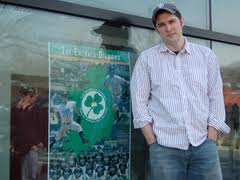 Today’s guest post is written by John Fitzgerald .
Today’s guest post is written by John Fitzgerald .
Like most young wannabe filmmakers, I learned the basics of screenwriting by hanging out on film sets and reading books.
Books such as Syd Field‘s 1979 treatise on the three-act dramatic structure, simply titled Screenplay. Fields contends that writers must follow a rigid three-act structure in order to free themselves to develop their characters.
Twitter’s 140-character limit is not unlike the three-act structure in screenwriting. It’s rigidity forces the writer to be disciplined and economical with words while creating a strong visual to convey the story.
The challenge in great storytelling is two-fold:
- To work within the constraints of the medium to make people empathize with the main character, the protagonist or,in your case, you/your organization.
- To create an emotional connection with the viewer. Screenwriting and tweeting both give the writer that power. Yet Twitter’s ability to incorporate photos and videos allows the user to go a step further than screenwriting allows, making it even more visual.
What would happen if you applied the storytelling principles of Screenplay in your every day Twitter usage?
It might go something like this:
-
People in Places, Doing Things
“A screenplay is like a noun – it’s about a person, or persons, in a place or places, doing his or her or their “thing.” All screenplays execute this basic premise. The person is the character, and doing his or her thing is the action.” – Syd Field
Think about that from a business perspective. The company is the who, the office or store is the where, and the line of business is the action. If you can convey these elements consistently in your tweets, you are telling a story.
-
The Audience Must Identify With the Protagonist
“Character is the essential foundation of your screenplay. It is the heart and soul and nervous system of your story. Before you put a word on paper, you must know your character.” – Syd Field
Small business owners are passionate about their line of work, but that passion isn’t easy to convey. It is one of the reasons why I’ve adapted my documentary filmmaking techniques to offer “Biz Docs” to small business owners. Just like we want to care about the protagonist in a movie, you need to help people care about the protagonist in your tweets.
-
Show, Don’t Tell
“The essence of character is action. Your character is what he does. Film is a visual medium, and the writer’s responsibility is to choose an image, or picture, that cinematically dramatizes his character.” – Syd Field
Sure, it’s easy to show a car chase, a love scene or a bank robbery. But how can a small business owner “show” their motivations for running a company?
A few ideas:- Customer Satisfaction: Tweet a video of a short customer testimonial. Taking a few minutes to record the video on your phone and then to Tweet it will show how much it means to you.
- Long hours – Tweet a photo when you leave the house and when you leave work every day. People will get the point without you having to complain (or boast!) about working a 15-hour day.
- Financial Investment/Risk – Tweet a photo of a new piece of equipment or a new product. Again, the photo and a short description is all you need.
-
Embrace Conflict
“All drama is conflict. Without conflict you have no character; without character, you have no action; without action, you have no story; and without story, you have no screenplay.” – Syd Field
Hollywood movies usually involve 120-minutes of continuous large-scale conflict that usually involves gunfire, explosions, and evil robots.
Let’s scale it back a few notches, shall we? There are plenty of conflicts that face small business owners. Share what you learned with others.
Oh, and another thing; Too much dialogue usually is the sign of a bad script. Tweet only when you have something useful to say.
By keeping things visual, your tweets can carry the story of your business farther and help you connect with customers.
Does this change your perspective on using Twitter?
John Fitzgerald is a documentary filmmaker. He produced The Emerald Diamond (2006) about the quirky history of Ireland’s National Baseball Team and Playing for Peanuts (2009) about a pro baseball team struggling to survive in an now defunct league. He learned social media by promoting his work back in the heyday of MySpace and AOL and currently serves as a social media consultant to several pro baseball teams and non-profits.